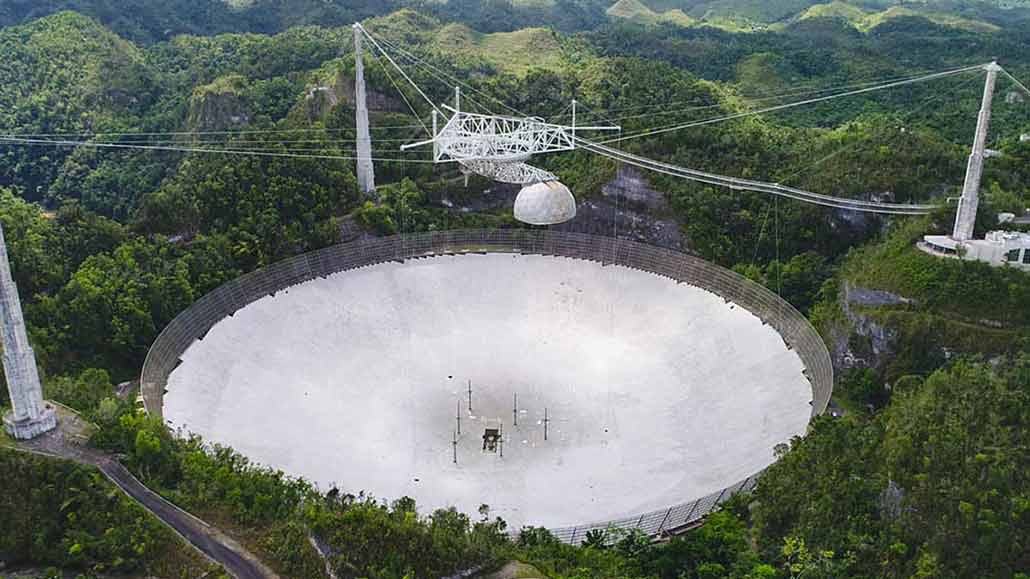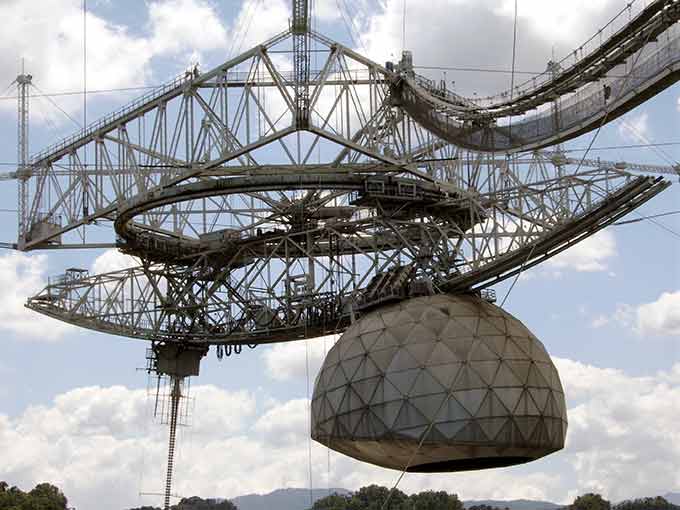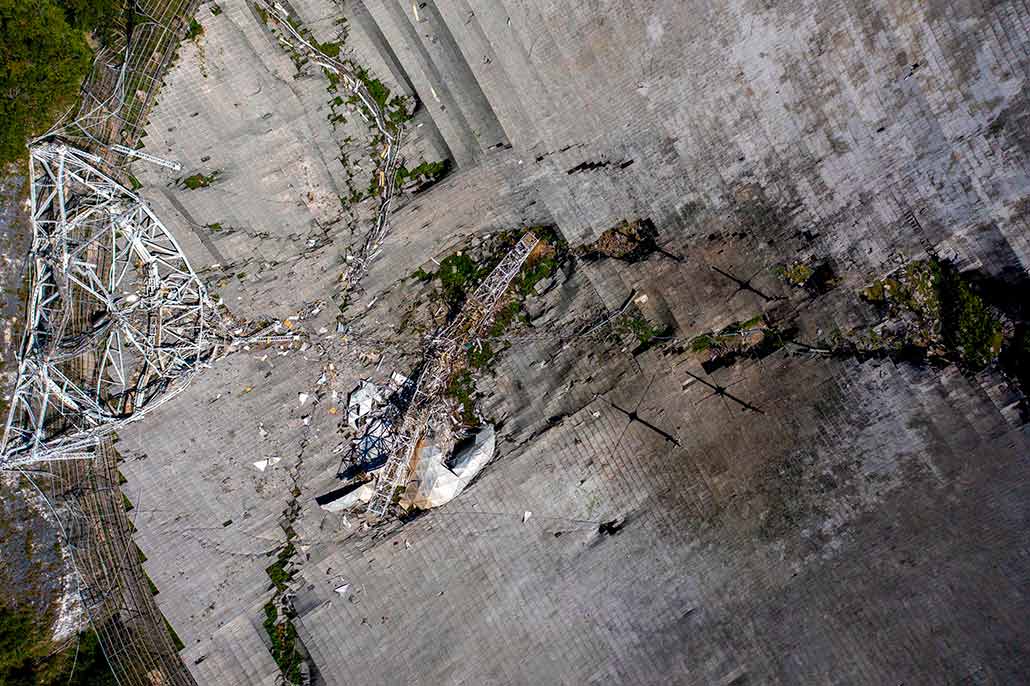Why Arecibo’s loss is such a big deal for astronomy
The telescope did a lot of important science, some of which isn’t being done elsewhere

In its 57-year lifetime, the huge radio telescope at the Arecibo Observatory in Puerto Rico (shown) made important discoveries in planetary science and astronomy. The telescope “died” when supports for the huge 900-ton instrument platform that had been suspended above it gave way, breaking the dish.
UNIVERSITY OF CENTRAL FLORIDA
Edgard Rivera-Valentín first visited the Arecibo Observatory as a little kid.
“I definitely remember this feeling of just being awestruck,” Rivera-Valentín says. The telescope was huge. People talked about the great work being done with it. And this important science was taking place right in the backyard of Rivera-Valentín’s hometown — Arecibo, Puerto Rico.
The boy dreamed of one day working there. And Rivera-Valentín in fact returned, years later. He used Arecibo to help map the shapes and motions of near-Earth asteroids. This planetary scientist now works at the Lunar and Planetary Institute. It’s in Houston, Texas. And even there, Rivera-Valentín uses data from Arecibo to study planets.
But there will be no new data coming from this telescope. On December 1, a 900-ton instrument platform that was suspended above the telescope’s large, light-gathering dish collapsed. It destroyed the dish. But even before this happened, two of the cables supporting that platform had recently failed. This sealed Arecibo’s fate. The telescope would have to be dismantled. And it would not be rebuilt.
Learning now that this observatory is damaged beyond repair, the scientist says, has been nothing less than “heartbreaking.”
For Puerto Rico, losing Arecibo is like New York City losing the Empire State Building. Or San Francisco losing its Golden Gate Bridge. But Rivera-Valentín sees an added tragedy here. Arecibo was not just a cultural icon. It also has been a major research center.
Its radar maps of the moon helped NASA pick landing sites for the Apollo moon missions in the 1960s. Its maps also helped point to landing sites for NASA’s Viking missions to Mars in the mid-70s. Arecibo’s images of the asteroid Bennu helped NASA plan a trip there. (The space agency’s OSIRIS-REx mission sampled a piece of Bennu this past October.) And Arecibo images revealed hydrocarbon lakes on the Saturn’s moon Titan.
The telescope also has observed mysterious flashes from deep space. They’re known as fast radio bursts. The telescope has even been used for decades in SETI — the search for extraterrestrial intelligence. In fact, it beamed the first radio message for aliens into space in 1974.

What makes Arecibo so special
Tony Beasley agrees that “Arecibo is a big loss.” He directs the National Radio Astronomy Observatory. It’s in Charlottesville, Va. Astronomers will have to see which of Arecibo’s work other telescopes can take over, he says.
But many of its roles can’t easily be replaced.
“Arecibo was unique in several ways,” says Donald Campbell. He’s an astronomer at Cornell University in Ithaca, N.Y. He also is a former director of the Arecibo observatory. For starters, the telescope’s dish was enormous. A whopping 305 meters (1,000 feet) across, it covered some 8.1 hectares (20 acres). That made it the world’s largest radio dish when it was built in 1963. It kept that title until 2016. That’s the year China completed a bigger observatory. Called FAST, it stands for Five-Hundred-Meter Aperture Spherical Telescope.
With a big dish to collect radio waves, Arecibo could see very faint objects. That made the dish great at detecting hard-to-spot objects. These included spinning neutron stars, known as called pulsars. As it rotates, a pulsar sweeps a beam of radio waves. It’s like a lighthouse. From Earth, this beam appears as a radio beacon flickering on and off.

“Arecibo was the king” of spotting pulsars, Beasley says. The next biggest radio dish in the United States is the 100-meter-wide Green Bank Telescope. It’s in West Virginia. Smaller telescopes might need to watch a target for several hours to collect enough radio waves for analysis. Arecibo could do the same thing in mere minutes.
Arecibo also could send out radio waves. China’s FAST may be bigger than Arecibo, and the Green Bank Telescope is near to U.S. astronomers, but neither is outfitted with radar transmitters. In fact, most radio telescopes are not, Campbell says. “They’re just receiving radio waves from space.”
Arecibo’s transmitters allowed it to bounce radio waves off of gases in the atmosphere or asteroids and planets. Those reflected signals brought back information, such as a target’s size, shape and motion.
The first main role for this telescope was to study Earth’s ionosphere, Campbell notes. The U.S. military, which paid to have Arecibo built, wanted to better understand Earth’s atmosphere to aid work in building missile defenses. But Arecibo’s radar transmitters also were used to study Earth’s moon, other planets and their moons. “More recently, the emphasis has been on studying near-Earth asteroids,” Campbell adds. Some of which might be threaten to collide with Earth.
Even in late 2020, the 57-year-old Arecibo Observatory still had “a bright scientific future,” says Joan Schmelz. She’s an astronomer at the Universities Space Research Association. It’s in Mountain View, Calif. She also used to be a deputy director at Arecibo. The telescope was a key facility for the NANOGrav project. It uses pulsar data to search for ripples in spacetime — ones kicked up by supermassive black holes.
Arecibo’s observing days may be over, but that doesn’t mean its data will lose their value, Schmelz says. Some of radio astronomy’s most exciting discoveries have emerged from sifting through old telescope data. “People will be continuing to analyze Arecibo data for some time,” she says. Look for those studies to yield more discoveries.







